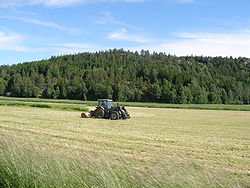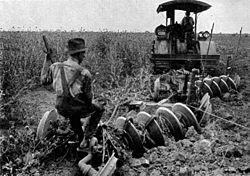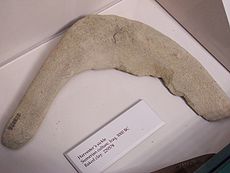Agriculture
Farming redirects here. For Farming in computer games, see Farmer (gaming). Template:Portal
Agriculture (a term which encompasses farming) is the process of producing food, feed, fiber and other goods by the systematic raising of plants and animals.
Agri is from Latin ager ("a field"), and culture is from Latin cultura, meaning "cultivation" in the strict sense of tillage of the soil. A literal reading of the English word yields: tillage of the soil of a field. In modern usage, the word Agriculture covers all activities essential to food/feed/fiber production, including all techniques for raising and processing livestock no less than those essential to crop farming.
Continual improvement in agricultural methods from Prehistory to the present has been the key factor in the extreme specialization of human activity during the historical epoch. Many of these specializations have nothing to do with food production, but when specialists such as scientists, inventors and mechanical and chemical engineers devote their efforts to the improvement of farming methods, resources and implements, they too, along with those who work the fields and pens, are "in agriculture".
42% of the world's population is employed in agriculture, making it by far the most common occupation, yet it accounts for less than 5% of the Gross World Product (an aggregate of all Gross Domestic Products).[1]
Overview
- "Oh Farmers, Pray That Your Summers Be Wet And Your Winters Clear." - Virgil
Farming sometimes refers to subsistence agriculture, the production of enough food to meet just the needs of the farmer/agriculturalist and his/her family. It may also refer to industrial agriculture, (often referred to as factory farming) long prevalent in developed nations and increasingly so elsewhere, which consists of obtaining financial income from the cultivation of land to yield produce, the commercial raising of animals (animal husbandry), or both.
Agriculture is also short for the study of the practice of agriculture—more formally known as agricultural science.
Increasingly, in addition to food for humans and animal feeds, agriculture produces goods such as cut flowers, ornamental and nursery plants, timber or lumber, fertilizers, animal hides, leather, industrial chemicals (starch, sugar, ethanol, [butanol], other alcohols and plastics), fibers (cotton, wool, hemp, and flax), the modern fibre building block [propanediol], fuels (methane from biomass, biodiesel), and both legal and illegal drugs (biopharmaceuticals, tobacco, marijuana, opium, cocaine). Genetically engineered plants and animals produce specialty drugs.
In the Western world,crop breeding based on scientific genetics, and most recently the use of gene manipulation, better management of soil nutrients,availablity of synthetic fertilizers and improved weed control have greatly increased yields per unit area. At the same time, the use of mechanization has decreased labour requirements. The developing world generally produces lower yields, having less access to the latest technology, and in some cases, as in much of Africa, faced with high fertilizer costs.
Modern agriculture depends heavily on engineering and technology and on the biological and physical sciences. Irrigation, drainage, conservation and sanitary engineering, each of which is important in successful farming, are some of the fields requiring the specialized knowledge of agricultural engineers.
Agricultural chemistry deals with other vital farming concerns, such as the application of fertilizer, insecticides (see Pest control), and fungicides, soil makeup, analysis of agricultural products, and nutritional needs of farm animals.Plant breeding and genetics contribute additionally to farm productivity. Advanced seed engineering has allowed strains of seed to be perfected for most farming situations. Seeds can now germinate faster and adapt to shorter growing seasons in different climates. Present-day seed can resist the spraying of pesticides that kill all green-leaf plants. Hydroponics, a method of soilless gardening in which plants are grown in chemical nutrient solutions, may help meet the need for greater food production as the world's population increases.
The packing, processing, and marketing of agricultural products are closely related activities also influenced by science. Methods of quick-freezing and dehydration have increased the markets for farm products (see Food preservation; Meat packing industry).
Mechanization, the outstanding characteristic of late 19th and 20th century agricultural evolution, has eased much of the backbreaking toil of the farmer. More significantly, mechanization has enormously increased farm efficiency and productivity (see Agricultural machinery). Animals, including horses, mules, oxen, camels, llamas, alpacas, and dogs; however, are still used to cultivate fields, harvest crops and transport farm products to markets in many parts of the world.
Airplanes, helicopters, trucks and tractors are used in agriculture for seeding, spraying operations for insect and disease control, Aerial topdressing, transporting perishable products, and fighting forest fires. Radio and television disseminate vital weather reports and other information such as market reports that concern farmers. Computers have become an essential tool for farm management.
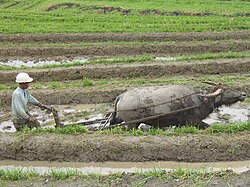
According to the National Academy of Engineering in the US, agricultural mechanization is one of the 20 greatest engineering achievements of the 20th century. Early in the century, it took one American farmer to produce food for 2.5 people, where today, due to engineering technology (also, plant breeding and agrichemicals), a single farmer can feed over 130 people [2]. This comes at a cost, however, of large amounts of energy input, from unsustainable, mostly fossil fuel, sources.
Animal husbandry means breeding and raising animals for meat or to harvest animal products (like milk, eggs, or wool) on a continual basis.
In recent years some aspects of industrial intensive agriculture have been the subject of increasing discussion. The widening sphere of influence held by large seed and chemical companies, meat packers and food processors has been a source of concern both within the farming community and for the general public. There has been increased activity of some people against some farming practices, raising chickens for food being one example. Another issue is the type of feed given to some animals that can cause Bovine Spongiform Encephalopathy in cattle. There has also been concern because of the disastrous effect that intensive agriculture has on the environment. In the US, for example, fertilizer has been running off into the Mississippi for years and has caused a dead spot in the Gulf of Mexico, where the Mississippi empties. Intensive agriculture also depletes the fertility of the land over time and the end effect is that which happened in the Middle East, where some of the most fertile farmland in the world was turned into a desert by intensive agriculture.
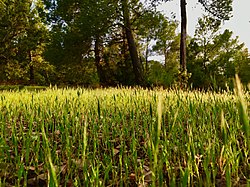
The patent protection given to companies that develop new types of seed using genetic engineering has allowed seed to be licensed to farmers in much the same way that computer software is licensed to users. Some critics argue that his has changed the balance of power in favor of the seed companies, allowing them to dictate terms and conditions previously unheard of, but hybrid corn seed companies evolved a similar arrangement with their clients when hybrid vigour was discovered early in the 20th century because the farmers obtained economic benefits from commercial seed. Some argue biotechnology based seed companies companies are guilty of biopiracy[3]. Others point out that delays in introduction of technology to the detriment of the poor caused by opposition generated by rich countries is a variant of eco-imperialism [4].
Soil conservation and nutrient management have been important concerns since the 1950s, with the best farmers taking a stewardship role with the land they operate. However, increasing contamination of waterways and wetlands by nutrients like nitrogen and phosphorus are of concern in many countries.
Increasing consumer awareness of agricultural issues has led to the rise of community-supported agriculture, local food movement, Slow Food, and commercial organic farming, though these yet remain fledgling industries.
History
Ancient Origins
Agriculture is believed to have been developed at multiple times in multiple areas, the earliest of which seems to have been in Mesopotamia.[5] Pinpointing the absolute beginnings of agriculture is problematic because the transition away from purely hunter-gatherer societies, in some areas, began many thousands of years before the invention of writing. Nonetheless, Archaeobotanists/Paleoethnobotanists have traced the selection and cultivation of specific food plant characteristics, such as a semi-tough rachis and larger seeds, to just after the Younger Dryas (about 9,500 BC) in the early Holocene in the Levant region of the Fertile Crescent. Limited anthropological and archaeological evidence both indicate a grain-grinding culture farming along the Nile in the 10th millennium BC using the world's earliest known type of sickle blades. There is even earlier evidence for conscious cultivation and seasonal harvest: grains of rye with domestic traits have been recovered from Epi-Palaeolithic (10,000+ BC) contexts at Abu Hureyra in Syria, but this appears to be a localised phenomenon resulting from cultivation of stands of wild rye, rather than a definitive step towards domestication. In these contexts lie the origins of the eight so-called founder crops of agriculture: first emmer and einkorn wheat, then hulled barley, peas, lentils, bitter vetch, chick peas and flax. These eight crops occur more or less simultaneously on PPNB sites in this region, although the consensus is that wheat was the first to be sown and harvested on a significant scale.
By 7000 BC sowing and harvesting reached Mesopotamia and there, in the super fertile soil just north of the Persian Gulf, Sumerian ingenuity systematized it and scaled it up. By 6000 BC farming was entrenched on the banks of the Nile River, and by 5000 BC it spread to Greece on one side and to India on the other. About this time, agriculture was developed independently in China, with rice rather than wheat as the primary crop. Maize was first domesticated from teosinte in the Americas around 3000-2700 BC. Somewhat surprisingly, systematic farming, principally of emmer and einkorn, reached northwestern Europe not via the Levant-to-Southern Europe but from central Asia by ca. 4,500 BC (see, among others, Price, D. [ed.] 2000. Europe's First Farmers. Cambridge University Press; Harris, D. [ed.] 1996 The Origins and Spread of Agriculture in Eurasia. UCL Press).
The reasons for the earliest introduction of farming may have included climate change, but possibly there were also social reasons (e.g. accumulation of food surplus for competitive gift-giving). Most certainly there was a gradual transition from hunter-gatherer to agricultural economies after a lengthy period when some crops were deliberately planted and other foods were gathered from the wild. Although localised climate change is the favoured explanation for the origins of agriculture in the Levant, the fact that farming was 'invented' at least three times, possibly more, suggests that social reasons may have been instrumental.
Full dependency on domestic crops and animals did not occur until the Bronze Age, by which time wild resources contributed a nutritionally insignificant component to the diet. If the operative definition of agriculture includes large scale intensive cultivation of land, mono-cropping, organized irrigation, and use of a specialized labour force, the title "inventors of agriculture" would fall to the Sumerians, starting ca. 5,500 BC. Intensive farming allows a much greater density of population than can be supported by hunting and gathering and allows for the accumulation of excess product to keep for winter use or to sell for profit. The ability of farmers to feed large numbers of people whose activities have nothing to do with material production was the crucial factor in the rise of standing armies. The agriculturalism of the Sumerians allowed them to embark on an unprecedented territorial expansion, making them the first empire builders. Not long after, the Egyptians, powered by effective farming of the Nile valley, achieved a population density from which enough warriors could be drawn for a territorial expansion more than tripling the Sumerian empire in area.Template:Fact
Agriculture in the Middle Ages
The Middle Ages owe much of its development to the advances made by the Muslims, as Islamic culture flowered while Europe and other Roman and Byzantine administered lands entered an extended period of societal stagnation. As early as the ninth century, a modern agricultural system became central to economic life and organization in the Arab caliphates. The great cities of the Near East, North Africa and Moorish Spain were supported by elaborate agricultural systems that included extensive irrigation based on expert knowledge of hydraulic and hydrostatic principles. In later centuries, Persian Muslims became a radically active force, transmitting cultural elements including advanced agriculture into Turkic lands and western India. The Muslims introduced what was to become an agricultural revolution based on four key areas:
• Development of a sophisticated system of irrigation using machines such as norias (newly invented water raising machines), dams and reservoirs. With such technology they managed to greatly expand the exploitable land area.
• The adoption of a scientific approach to farming enabled them to improve farming techniques derived from the collection and collation of relevant information throughout the whole of the known world. Farming manuals were produced in every corner of the Muslim world detailing where, when and how to plant and grow various crops. Advanced scientific techniques allowed leaders like Ibn al-Baytar to introduce new crops and breeds and strains of livestock into areas where they were previously unknown.
• Incentives based on a new approach to land ownership and labourers' rights, combining the recognition of private ownership and the rewarding of cultivators with a harvest share commensurate with their efforts. Their counterparts in Europe struggled under a feudal system in which they were almost slaves (serfs) with little hope of improving their lot by hard work.
• The introduction of new and a variety of crops transforming private farming into a new global industry exported everywhere including Europe, where farming was mostly restricted to wheat strains obtained much earlier via central Asia. Spain received what she in turn transmitted to most Europe; all manner of agricultural and fruit-growing processes, together with a vast number of new plants, fruit and vegetables. These new crops included sugar cane, rice, citrus fruit, apricots, cotton, artichokes, aubergines, and saffron. Others, previously known, were developed further. Muslims also brought to that country lemons, oranges, cotton, almonds, figs and sub-tropical crops such as bananas and sugar cane were grown on the coastal parts of the country, many to be taken later to the Spanish colonies in the Americas. Also owing to the Muslim influence, a silk industry flourished, flax was cultivated and linen exported, and esparto grass, which grew wild in the more arid parts, was collected and turned into various articles.
Rennaisance to Present Day
The invention of a three field system of crop rotation during the Middle Ages vastly improved agricultural efficiency.
After 1492 the world's agricultural patterns were shuffled in the widespread exchange of plants and animals known as the Columbian Exchange. Crops and animals that were previously only known in the Old World were now transplanted to the New and vice versa. Perhaps most notably, the tomato became a favorite in European cuisine, with maize and the potato widely grown, while certain wheat strains quickly took to western hemisphere soils and became a dietary staple even for native North, Central and South Americans.
By the early 1800s agricultural practices, particularly careful selection of hardy strains and cultivars, had so improved that yield per land unit was many times that seen in the Middle Ages and before, especially in the largely virgin lands of North and South America. With the rapid rise of mechanization in the 20th century, especially in the form of the tractor, the demanding tasks of sowing, harvesting and threshing could be performed with a speed and on a scale barely imaginable before. These advances have led to efficiencies enabling certain modern farms in the United States, Argentina, Israel, Germany and a few other nations to output volumes of high quality produce per land unit at what may be the practical limit.
Crops
World production of major crops in 2004
Specific crops are cultivated in distinct growing regions throughout the world. In millions of metric tons, based on FAO estimates.
| Top agricultural products, by crop types (million metric tons) 2004 data | |
|---|---|
| Cereals | 2,264 |
| Vegetables and melons | 866 |
| Roots and Tubers | 715 |
| Milk | 619 |
| Fruit | 503 |
| Meat | 259 |
| Oilcrops | 133 |
| Fish (2001 estimate) | 130 |
| Eggs | 63 |
| Pulses | 60 |
| Vegetable Fiber | 30 |
| Source: UN Food & Agriculture Organisation (FAO)[6] | |
| Top agricultural products, by individual crops (million metric tons) 2004 data | |
|---|---|
| Sugar Cane | 1,324 |
| Maize | 721 |
| Wheat | 627 |
| Rice | 605 |
| Potatoes | 328 |
| Sugar Beet | 249 |
| Soybean | 204 |
| Oil Palm Fruit | 162 |
| Barley | 154 |
| Tomato | 120 |
| Source: UN Food & Agriculture Organisation (FAO)[7] | |
Crop improvement

Domestication of plants is done in order to increase yield, improve disease resistance and drought tolerance, ease harvest and to improve the taste and nutritional value and many other characteristics. Centuries of careful selection and breeding have had enormous effects on the characteristics of crop plants. Plant breeders use greenhouses and other techniques to get as many as three generations of plants per year so that they can make improvements all the more quickly.
Plant selection and breeding in the 1920s and '30s improved pasture (grasses and clover) in New Zealand. Extensive radiation mutagenesis efforts (i.e. primitive genetic engineering) during the 1950s produced the modern commercial varieties of grains such as wheat, corn and barley. Direct treatment with radiation is the most widely used method for developing mutant varieties of food crop, and more than new 2250 mutant crop varieties have been released into general use over the last seventy years. These mutant varieties comprise 175 different plant species, including rice, wheat, cotton, rapeseed, sunflower, sesame, grapefruit and banana. [8]
For example, average yields of corn (maize) in the USA have increased from around 2.5 tons per hectare (40 bushels per acre) in 1900 to about 9.4 t/ha (150 bushels per acre) in 2001, primarily due to improvements in genetics. Similarly, worldwide average wheat yields have increased from less than 1 t/ha in 1900 to more than 2.5 t/ha in 1990. South American average wheat yields are around 2 t/ha, African under 1 t/ha, Egypt and Arabia up to 3.5 to 4 t/ha with irrigation. In contrast, the average wheat yield in countries such as France is over 8 t/ha. Higher yields are due to improvements in genetics, as well as use of intensive farming techniques (use of fertilizers, chemical pest control, growth control to avoid lodging).Template:Fact [Conversion note: 1 bushel of wheat = 60 pounds (lb) ≈ 27.215 kg. 1 bushel of corn = 56 pounds ≈ 25.401 kg]
In industrialized agriculture, crop "improvement" has often reduced nutritional and other qualities of food plants to serve the interests of producers. After mechanical tomato-harvesters were developed in the early 1960s, agricultural scientists bred tomatoes that were harder and less nutritious (Friedland and Barton 1975). In fact, a major longitudinal study of nutrient levels in numerous vegetables showed significant declines in the last 50 years; garden vegetables in the U.S. today contain on average 38 percent less vitamin B2 and 15 percent less vitamin C (Davis and Riordan 2004).
Recently, often amid controversy, genetic engineeringhas begun to be employed in many parts of the world to speed up the selection and breeding process, and to widen the range of useful traits for crop breeding. The most widely used modification is a herbicide resistance gene that allows plants to tolerate exposure to glyphosate, which is used to control weeds in the crop and expand the possibilities for [conservation tillage]. Conservation or minimum-till helps minimize soil erosion, fuel use, and loss of soil carbon. Also now used are bacterial Bacillus thuringiensis (Bt) genes that causes the plant to produce an insect specific toxin that reduces crop damage by insects. Bt toxin has also reduced reliance on synthetic chemical pesticides [9] [10] [11] [12].
There are specialty producers who raise less common types of livestock or plants.
Aquaculture, the farming of fish, shrimp, and algae, is closely associated with agriculture.
Apiculture, the culture of bees, traditionally for honey—increasingly for crop pollination.
See also : botany, List of domesticated plants, List of vegetables, List of herbs, List of fruit
Environmental problems and their management
Agriculture may often cause environmental problems because it changes natural environments and produces harmful by-products. Some of the negative effects are:
- Nitrogen and phosphorus surplus in rivers and lakes.
- Detrimental effects of herbicides, fungicides, insecticides, and other biocides.
- Conversion of natural ecosystems of all types into arable land.
- Consolidation of diverse biomass into a few species.
- Soil erosion
- Depletion of minerals in the soil
- Particulate matter, including ammonia and ammonium off-gasing from animal waste contributing to air pollution
- Weeds - feral plants and animals
- Odor from agricultural waste
- Soil salination .
On the other, changes to agricultural practices can have beneficial environmental effects. For instance conservation tillage can be used to mitigate atmospheric emissions of carbon dioxide by preventing carbon loss from farm soils, or even promoting build-up of soil carbon content [13] [14].
Agriculture is cited as a significant adverse impact to biodiversity in many nations' Biodiversity Action Plans, due to reduction of forests and other habitats when new lands are converted to farming. Better farm productivity per unit area of farmland can, however, reverse the trend for arable land to encroach on forest and wilderness [15]. Some critics include agriculture as a significant contributer to current global climate change.
Policy
Agricultural policy focuses on the goals and methods of agricultural production. At the policy level, common goals of agriculture include:
- Food safety: Ensuring that the food supply is free of contamination.
- Food security: Ensuring that the food supply meets the population's current and future needs.
- Food quality: Ensuring that the food supply is of a consistent and known quality.
- Conservation
- Environmental impact
- Economic stability
Agricultural Revolutions
Methods
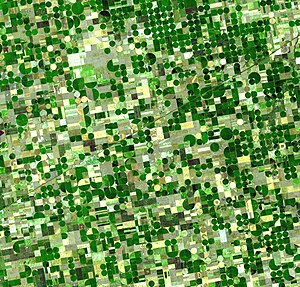
There are various methods of agricultural production:
- aeroponics
- aerial topdressing
- agricultural machinery
- animal husbandry
- aquaculture
- beekeeping
- crop rotation
- Concentrated Animal Feeding Operation (CAFO, factory farming)
- composting
- dairy farming
- detasseling
- domestication
- fencing
- fertilizers
- Geier Hitch
- greenhouse
- harvest
- heliciculture
- hybrid seed
- hydroponics
- Integrated Pest Management (IPM)
- irrigation
- livestock
- market gardening
- monoculture
- no-till farming
- organic farming
- plant breeding
- plasticulture
- Permaculture
- pollination management
- precision farming
- ranching
- season extension
- seed saving
- seed testing
- shepherding
- subsistence farming
- succession planting
- sustainable agriculture
- terracing
- vegetable farming
- tillage
- weed control
References
Artz, F. B, (1980), ‘The Mind of the Middle Ages’; Third edition revised; The University of Chicago Press,
Bolens, L. (1997), `Agriculture’ in Encyclopaedia of the history of Science, technology, and Medicine in Non Western Cultures, Editor: Helaine Selin; Kluwer Academic Publishers. Dordrecht/Boston/London, pp 20-2
Collinson, M. (editor): A History of Farming Systems Research. CABI Publishing, 2000. ISBN 0-85199-405-9
Crosby, Alfred W.: The Columbian Exchange : Biological and Cultural Consequences of 1492. Praeger Publishers, 2003 (30th Anniversary Edition). ISBN 0-275-98073-1
Davis, Donald R., and Hugh D. Riordan (2004) Changes in USDA Food Composition Data for 43 Garden Crops, 1950 to 1999. Journal of the American College of Nutrition, Vol. 23, No. 6, 669-682.
Friedland, William H. and Amy Barton (1975) Destalking the Wily Tomato: A Case Study of Social Consequences in California Agricultural Research. Univ. California at Sta. Cruz, Research Monograph 15.
Watson, A.M (1974), ‘The Arab agricultural revolution and its diffusion’, in The Journal of Economic History, 34,
Watson, A.M (1983), ‘ Agricultural Innovation in the Early Islamic World’, Cambridge University Press
Wells, Spencer: The Journey of Man : A Genetic Odyssey. Princeton University Press, 2003. ISBN 0-691-11532-X
Wickens, G.M.(1976), ‘What the West borrowed from the Middle east’, in Introduction to Islamic Civilisation, edited by R.M. Savory, Cambridge University Press, Cambridge
Citations
- ↑ The World Factbook, CIA
- ↑ [1]
- ↑ Biopiracy: The Plunder of Nature and Knowledge. Vandana Shiva (1997)
- ↑ Eco-Imperialism. Green Power. Black Death. Paul K. Driessen
- ↑ "A conversation with Christopher Ehret"
- ↑ [2]
- ↑ [3]
- ↑ Ahloowalia, B.S. Maluszynski M. and K. Nichterlein (2004). Global impact of mutation-derived varieties. Euphytica Volume 135, Number 2: pages, 187 - 204
- ↑ Adoption of Genetically Engineered Crops in the U.S. 2005 ERS, USDA
- ↑ ISAAA Briefs 34-2005: Global Status of Commercialized Biotech/GM Crops: 2005
- ↑ [ GM crops: the global socio-economic and environmental impact — the first nine years 1996–2004, PG Economics, Oct 12 2005
- ↑ A 2006 Update of Impacts on US Agriculture of Biotechnology-Derived Crops Planted in 2005, Sujatha Sankula, NCFAP
- ↑ Stern Review on the economics of climate change 2006
- ↑ Economics of Sequestering Carbon in the U.S. Agricultural Sector Jan Lewandrowski, Mark Peters, Carol Jones, Robert House, Mark Sperow, Marlen Eve, and Keith Paustian ERS USDA Technical Bulletin No. (TB1909) 69 pp, March 2004
- ↑ The Population/Biodiversity Paradox. Agricultural Efficiency to Save Wilderness, Anthony J. Trewavas Plant Physiol, January 2001, Vol. 125, pp. 174-179
See also
- Agricultural and Food Research Council, UK
- Agricultural education
- Agricultural science
- Agricultural sciences basic topics
- Agricultural Technology in Africa
- Agricultural Research in Africa
- Animal husbandry
- Arid-zone agriculture
- Barnyard
- Community-supported agriculture
- Horticulture
- International agricultural research
- Family farm hog pen
- Farm equipment
- Field husbandry
- Land Allocation Decision Support System
- List of domesticated animals
- List of subsistence techniques
- List of countries by agricultural output
- List of sustainable agriculture topics
- Permaculture
- Pizza farm
- Protein per unit area
- Timeline of agriculture and food technology.
- USA agriculture
- Urban agriculture
- Vertical farming
External links
- International Institute of Tropical Agriculture (IITA)
- www.fao.org — Food and Agriculture Organization of the United Nations World Agricultural Information Centre
- www.fao.org — The UN Statistical Databases
- www.fao.org/faostat — The FAOSTAT Statistical Databases
- www.fao.org/es/ess — The FAO Statistics Division
- FAO Agriculture Department and its State of Food and Agriculture 2003-2004 with a focus on the impact of biotechnology
- GM Crops in Agriculture – A summary for non-specialists of the above FAO report by GreenFacts.
- GMO Safety - Genetic Engineering, plants, environment.
- Check Biotech, University of Basel
- Information Systems for Biotechnology
- / Agriculture at the Open Directory Project
- Agriculture: Demon Engine of Civilization by John Zerzan
- Agriculture Network Information Center
- Food Security and Ag-Biotech News
- USDA, Economic Research Service
- UK Agriculture
ar:زراعة an:Agricultura ast:Agricultura bm:Sɛnɛkɛ bg:Земеделие ca:Agricultura cv:Ял хуçалăхĕ cs:Zemědělství cy:Amaeth da:Landbrug de:Landwirtschaft et:Põllumajandus es:Agricultura eo:Agrikulturo eu:Nekazaritza fa:کشاورزی fr:Agriculture fy:Lânbou fur:Agriculture ga:Talmhaíocht gd:Àiteachas gl:Agricultura ko:농업 io:Agrokultivo id:Pertanian ia:Agricultura iu:ᐱᕈᕐᓰᓂᖅ ᓂᐅᕐᕈᑎᒃᓴᓕᐊᕆᓪᓗᒋᑦ is:Landbúnaður it:Agricoltura he:חקלאות ka:სოფლის მეურნეობა lad:Agrikultura la:Agricultura lt:Žemės ūkis li:Landboew hu:Mezőgazdaság mk:Земјоделство nah:Millacayotl nl:Landbouw nds-nl:Laandbouw ja:農業 no:Landbruk nn:Landbruk nrm:Agritchultuthe ug:دېھقانچىلىق nds:Bueree pl:Rolnictwo pt:Agricultura ro:Agricultură ru:Сельское хозяйство sq:Agrokultura scn:Agricultura simple:Agriculture sl:Kmetijstvo sr:Пољопривреда sh:Poljoprivreda su:Agrikultur fi:Maatalous sv:Jordbruk tl:Agrikultura ta:வேளாண்மை vi:Nông nghiệp tr:Tarım uk:Сільське господарство vec:Agricultura zh:农业

